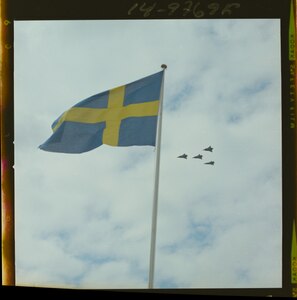GLAM/Newsletter/December 2023/Contents/Sweden report
|
Photo memories project concludes; Sörmlands museum passes 1000 uploads to Wikimedia Commons; Wikimedian in Residence supports an upload of music content; Subject terms from Queerlit; Wikidata for authority control: 3 years of work
Photo memories project concludes
100 000 Bildminnen, a joint project of Wikimedia Sverige and the Nordic Museum in Stockholm, concluded at the end of the year. In total, over 6,000 photos from the museum's archives were uploaded. These are just a small sample of the over 100,000 photos the museum digitized over the year, selected as to demonstrate the breadth of the collections. Selecting the photos to share on Wikimedia Commons was a big part of the project – we had many discussions with the museum about what would be most interesting and valuable for the Wikimedia community.
And the community's response has been very positive, with many photos getting improved descriptions and categorization; something the Nordic Museum is very thankful for, as they are going to use these contributions to improve the information in their own database. A great example of how the Wikimedia projects make it possible for experts all around the world to work together towards more free knowledge! Here are some examples of photos whose information has been improved:
-
This airplane is an J 34 Hunter...
-
...and these are called Saab 35 Draken.
-
This is the Karaya Beach in Monastir, Tunisia...
-
...and this is the amphitheatre of El Jem.
Sörmlands museum passes 1000 uploads to Wikimedia Commons and concludes third year of collaboration with Nyköping folkhögskola
With the latest upload to Commons from Sörmlands museum's collections, we have passed the bar of 1000 files. We have been continuously working with very curated and smaller uploads to Commons with files filling identified knowledge gaps in either Wikipedia or Wikidata. Examples are people missing pictures or articles missing relevant images to illustrate their contents. The latest upload has been the first one using Open Refine which has made the process much easier. Still, data cleansing before uploading the files to Commons is still the most time-consuming task. Exactly 25 percent of our files are used in 24 Wiki projects on more than 370 pages. We focus most on the usage aspect of our media files as it is not one more space to store our data apart from our collections management system and file servers. We want to see it being used actively.
Another Wikimedia project is our collaboration with Nyköping folkhögskola where adult students without a formal hish school diploma enrich Wikipedia articles with text, sources, and images. It was the third year of our collaboration and a great experience once again. It is a good opportunity to discuss access to and engagement with (local) history and museum collections. Here's some of the articles they have worked on:
As always, a huge thank you to all the Wikipedians who have supported the students with and after their edits!
Wikimedian in Residence supports an upload of music content
Wikimedia Sverige concluded the year by supporting Musikverket – the National Collections of Music, Theatre and Dance – in contributing a bunch of new material to Wikimedia Commons. We have a great relationship with them and have been working together for several years. It's become a tradition of sorts that every year we send a Wikimedian in Residence to their offices, where they not only prepare and upload their material, but also educate the staff about all things Wikimedia and facilitate an edit-a-thon. During the edit-a-thon nine participants added images and audio recordings to both articles and objects on Wikidata. Both staff from Musikverket and volunteers joined in to make sure the uploaded material came to use.
This time, we focused on two kinds of material. First of all, a lovely collection of high-resolution photos of musical instruments from the collections of the Swedish Museum of Performing Arts. Many of them are traditional Nordic folk instruments, like psalmodicons, langeleiks and Hardanger fiddles. But the museum boasts a collection of instruments from all over world, including both typical Western instruments like oboes and clarinets and items from Asia and Africa.
Secondly, we uploaded some audio recordings, focusing on psalmodicon music. The psalmodicon is not exactly a well-known instrument, making this collection unique and valuable to folk music enthusiasts and researchers.
All in all, over 5,000 files were uploaded in December.
Subject terms from Queerlit

The Swedish subject terms from Queerlit are now uploaded to Wikidata. There is more work to be done with the objects, for example they could be expanded with descriptions in more languages and if possible an identifier from, for example, Homosaurus can be added.
Wikidata for authority control: 3 years of work
Another big project that concluded in December 2023 was Wikidata for authority control, a collaboration between Wikimedia Sverige, the Nationalmuseum and the National Historical Museums of Sweden.
In this project, WMSE worked together with staff from the two museum to equip them with the tools and skills to be able to match the data in their own authority databases with Wikidata. In the conference paper Wikidata for authority control: sharing museum knowledge with the world, we write in detail about what the project entails and why it's important; in short, the participants have learned a lot about the open knowledge ecosystem, added thousands of external identifiers to Wikidata, wrote their own SPARQL queries, created many new items and used OpenRefine to clean up their data and edit Wikidata. Most importantly, they are now well equipped to spread knowledge about Wikidata, Linked Open Data and OpenRefine in the GLAM sector.
On WMSE's wiki, you can read (in Swedish) a summary of what has been done in the project.
















